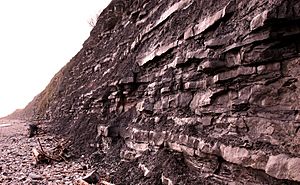Facies facts for kids

Facies is a special word used in geology, which is the study of Earth's rocks and history. It describes what a rock looks like and what features it has. Imagine looking at a tall cliff made of rock. You might see different layers, and each layer can look a bit different from the one above or below it. These different looks are what geologists call facies.
The way a rock layer looks tells us a lot about the environment where it was formed. For example, a rock formed in a deep ocean will look different from a rock formed on a sandy beach. This is because the conditions, like the water depth, the amount of sand or mud, and the types of living things, changed as the rock layers were being laid down. So, facies help scientists understand the ancient world.
What are Facies?
Facies are all the features of a sedimentary rock that help us guess what kind of environment it formed in. These features include the rock's color, its texture (like how rough or smooth it feels), the types of minerals it contains, and any fossils found within it.
How Facies Change
Sometimes, you can see regular changes in facies as you look up a rock cliff. This often means that the ancient climate was changing in a regular way. For example, as the climate changed, the sea level might have gone up and down. What was once deep water could become shallow water, and then deep water again.
One reason for these regular changes is something called the Milankovich cycle. This cycle describes how Earth's orbit and tilt change over very long periods, which affects our planet's climate. As the climate shifts, different types of rocks are formed. For instance, rocks made in deep ocean water (like carbonates) might switch with rocks formed in shallow water (like shales and silts). These different rock types, or facies, can be clearly seen when you look at a column of rocks.
By studying these different facies, geologists can piece together the story of Earth's past, learning about ancient seas, climates, and landscapes.
Images for kids
-
Eolianite carbonate facies (Holocene) on Long Island, Bahamas
See also
 In Spanish: Facies para niños
In Spanish: Facies para niños




